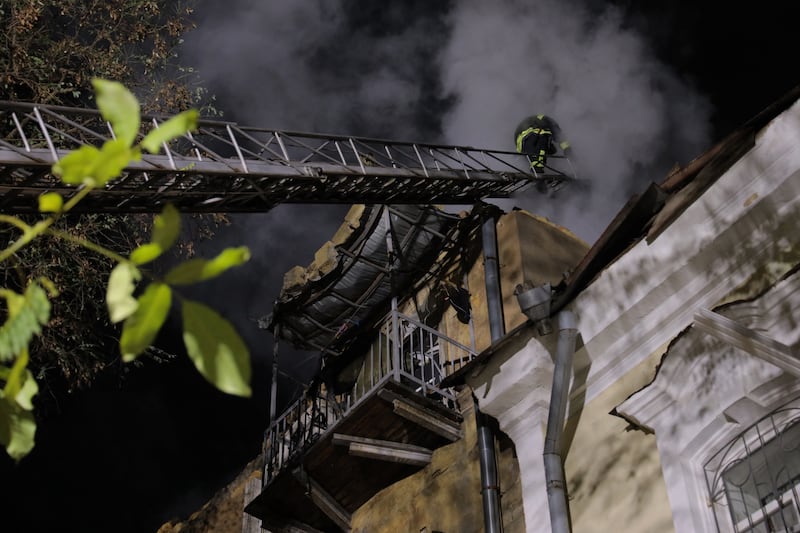Ukrainian soldiers going into a third winter of all-out war with Russia face a grimly familiar task alongside a new and urgent challenge: holding back a bigger and better-armed enemy while putting their country in the strongest possible position for the return of Donald Trump to the White House.
The US president-elect has claimed he could end the war in one day and will have the chance to prove all the doubters wrong after his inauguration on January 20th.
Trump has not revealed how he plans to persuade Russia to abandon the full-scale invasion launched in February 2022, but the most likely approach would be to press Ukraine to accept the loss of some territory in exchange for peace – though Kyiv publicly rejects any such trade-off, and polls show most of the nation would also oppose it.
By Kyiv’s reckoning, Russia has now sent 50,000 troops into its Kursk border region to try to retake the area and deprive Ukraine of a useful bargaining chip in the kind of talks that Trump may seek to broker.
READ MORE
North Korean troops are now also fighting for Russia in Kursk, after Pyongyang sent an estimated 10,000 soldiers to bolster its ally’s ranks under a mutual defence pact signed by the two countries’ autocratic leaders.
[ The Irish Times view on Trump and Ukraine: Change of course is aheadOpens in new window ]
Battlefield monitoring shows that Russia is chipping away at the 1,000 square kilometres or so of the Kursk region that Ukraine seized in a surprise attack in August, and that Kyiv’s forces in the area must be alert to the danger of possible encirclement.
In eastern Ukraine, Russia is combining massed frontal attacks with raids by smaller and more mobile assault groups against the flanks of Ukrainian positions, searching for weak points in defences and threatening to surround isolated units.
Kyiv claims that the Kursk attack thwarted Russian plans to seize swathes of the Sumy region of northern Ukraine and pinned down troops that could otherwise have been used to expand the invasion force in eastern Ukraine. The sight of Ukrainian flags flying over Russian towns and villages was also an embarrassment to the Kremlin and a morale boost for war-weary Ukrainian soldiers and civilians.

Yet the risky operation also stretched Ukraine’s forces even thinner across a wider area and failed in the key objective of forcing Russia to redeploy units away from eastern Ukraine to defend Kursk.
Russia has been edging forward in the Donetsk region all year in a slow and bloody grind through abandoned fields and mostly deserted villages, punctuated by the capture of the strategic towns of Avdiivka and Vuhledar in February and October respectively.
Ukraine continues to inflict heavy losses on the enemy – British military intelligence says October was the worst month of the war for Russian casualties, with an average of 1,500 soldiers killed or injured every day – but this has not stopped Russia’s advance towards the small city of Pokrovsk, which has been a staging post for Kyiv’s forces in the region since fighting began there in 2014. Russian troops are now about 10km from the heavily fortified city, from which most residents have been evacuated.
Russia is also stepping up attacks in the south of the Donetsk region where it meets Zaporizhzhia province, and on the town of Kupiansk in the northeastern Kharkiv region, a transport hub that was occupied for about seven months in 2022.
Though Ukraine’s disadvantage in artillery shells is now far smaller than at several earlier stages of the war, its shortage of air defence systems and fighter jets – which western allies have failed to address despite repeated promises – leaves its frontline troops, cities and infrastructure at the mercy of the massive guided bombs that Russia launches from aircraft flying safely more than 50km from their targets.
The prospect of life in the trenches under constant threat from these so-called KAB glide bombs, which weigh up to three tonnes, has done nothing to help replenish the ranks of Ukraine’s tired, overstretched, patched-up and understaffed military.
Attempts to broaden and accelerate mobilisation have not delivered troops of the required quality and quantity to badly depleted units, some of which have been fighting without a break for more than two years.
Stories of poorly prepared young men being sent into battle too soon, coupled with near daily reports of corruption in the mobilisation process and footage of draft officers wrangling unwilling conscripts in cafes, clubs and shopping centres, has further damaged morale far from the front line; at the same time, tens of thousands of soldiers have fled their units since 2022, and the desertion rate has risen sharply this year.
“The situation is serious and urgent for many reasons ... Manpower and force employment issues are challenges right now, and manpower is stretched across the front,” Dara Massicot, a senior fellow at the Carnegie Endowment for International Peace, wrote on social media this week after visiting eastern Ukraine.
“The Russians can rotate and regenerate forces better than Ukraine can right now ... On the current path, both Ukraine and Russia are headed for exhaustion in different ways. My concern is that Ukraine reaches it first if no changes are made.”
- Listen to our Inside Politics Podcast for the latest analysis and chat
- Sign up for push alerts and have the best news, analysis and comment delivered directly to your phone
- Find The Irish Times on WhatsApp and stay up to date














